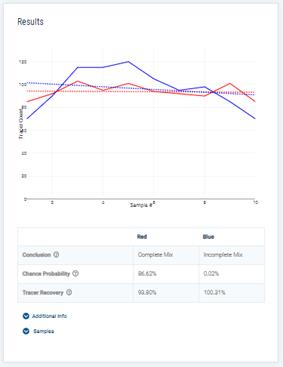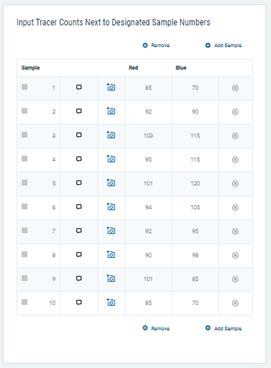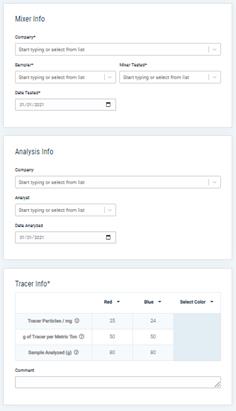 Article by David and Zachary Eisenberg
Article by David and Zachary Eisenberg
Microtracers® are used worldwide to assure quality of mixed feeds. They are used to identify the presence of additives and premixes in final feeds and to confirm the integrity of proprietary pharmaceuticals. In the poultry industry Microtracers® validate cross-contamination control procedures to prevent violative residues. This article describes the procedure to verify the accuracy of feed mixing.
The cost of validating the accuracy of mixers is trivial when compared with the costs of non-uniform diets that may impact animal performance. Inefficient mixer performance will require longer mixing times or smaller batch sizes than needed, wasting resources and reducing feedmill capacity.
Microtracers® provide significant advantages over alternate tracers used to validate mixing including assays of amino acids, minerals and salt.
- Microtracers® can be assayed either in a mill by non-technical personnel or in a feed laboratory. Assays are conducted rapidly and at a fraction of the cost of amino acid or mineral analyses.
- Microtracers® are added to feeds at 50 parts per million (ppm) or less as compared with salt added at 2% (20,000 ppm).
- Microtracers® are added to feeds as a discrete inclusion. Results obtained are not confounded by background levels of amino acids, minerals or salt in feed.
- Microtracers can be used to detect extremely low levels of cross-contamination, by analyzing sequential samples.
- Microtracers® are included in the Standard of the American Society of Agricultural and Biological Engineers (ASABE) (USA) and in the GMP+ Test Methods (Holland).
The four steps to validate mixer performance using Microtracers® are:-
- Addition of the Microtracer® to the feed
- Sampling the feed after mixing
- Analyzing the feed samples for the Microtracer®
- Interpreting data
1) Addition of the Microtracer® to the Feed
The most common analytical procedure uses Microtracers® F. comprising 25,000 particles/gram. This Microtracer® is added to the trial feed at 50 grams per 2,000-lbs of feed or bulk feed premix to yield an expected 103 particles/colored spots from analysis of 75 gram subsamples.
The Microtracer® should be mixed in the proportion of 1 part tracer with 9 parts of extender such as limestone powder to simulate commercial practice where critical micro ingredients such as vitamins, minerals or drugs are added to a feed as a premix.
The Microtracer® premix should be added to the mixer at the same position and time that other micro ingredients are added -- whether by hand or from an automated microbin.
For paddle mixers, two different colored Microtracer® F products should be added with one at each end of the mixer. This allows validation of end-to-end distribution of the tracer in the mixer.
Two or even three mixing times can be validated in one test batch by adding different colors of tracer sequentially into the batch.
For example Microtracer F-Blue could be added at the time the mixer is fully loaded; Microtracer F-Red after one minute and Microtracer F -Orange after two minutes. Then the mixer could be left to mix for an additional minute. For the samples taken, the Blue tracer will have mixed 3 minutes, the Red for 2 minutes and the Orange for one minute.
2) Sampling Feed After Mixing
The location of sampling depends on the purpose of the trial.
- To validate performance of the mixer, samples are obtained from within the mixer at different locations and depths.
- To evaluate the mixing quality of the feed or premix at the point of transfer from the mixer, samples should be taken at the point of discharge.
- To evaluate the mixing quality of the feed or premix prior to delivery, samples can be obtained directly from the vehicle discharge auger or from bags of feed.
Variability in mixing usually increases after discharge from the mixer science feed with tracer may commingle with feed not containing the tracer as cross contamination from prior batches of feed or premix may occur.
A minimum of ten samples is recommended per batch. All samples must be discrete (not composites) and they should not be mixed prior to analysis since this reduces the power of the test. Tracer counts should be obtained from 75 g. units of feed not 200 g. units. A minimum of 200g per sample is recommended to permit retests if required.
In taking samples, safety must be the highest priority. It may be necessary to shut off power to a mixer if samples are taken from within a mixer or to a screw conveyer when samples are taken from the screw conveyer. Hands must never be placed between the conveyer screws even if power is shut off.
3) Analyzing the Microtracer® in Feed
The analytical procedure is summarized below:-
- Lift the subsample from the top of the sample bag and weigh it in a weigh scoop or dish on a laboratory scale (75 suggested).
- Pour the sample through the upper hopper of a “Rotary Detector” laboratory magnetic separator to isolate the tracer on a sheet of filter paper resting over the rotating magnet.
- Brush the magnetically retrieved material including Microtracer® into a small aluminum weigh scoop and use a bulk tape eraser to “demagnetize” the material.
- Sprinkle the retrieved material onto a large, 7 inch (18cm) diameter filter paper and use an artist's fan-shaped brush to disperse the tracer evenly on the test paper.
- Use a polyethylene spray bottle with special head to “mist” the developing solution of 50% ethyl alcohol over the surface of the filter paper. As soon as colored spots begin to develop, transfer the test paper to a pre-heated hot plate or oven to dry the paper and “fix” the spots.
- Determine the number of spots by eye using a hand-held counter or use a Microtracer® spot-counting app. (free download for Android and iOS devices).
The Microtracer® “Rotary Detector” and peripherals including “bulk tape eraser”, hot plates, grinder (to reduce feed pellets to mash for analysis), filter paper as well as Microtracers® F can be purchased form Micro-Tracers, Inc., San Francisco.
A video of the rotary detector analytical procedure can be found at this link.
4) Interpreting Data
Microtracer® F particles yield colored spots that are counted as described above. Comparison of values is governed by Poisson particle statistics and the Chi-Squared test rather than percentage Coefficient of Variation (CV%) .
Click here for more information on the statistical interpretation of Microtracers® results.
Data is entered into either the Microtracer® Web Portal or App. (data input into one will sync to the other). The Portal or App will then calculate all statistics and provide a determination whether the mix is complete.
Completeness of a mix is determined by applying the Chi-Square test, which yields a “Chance Probability” or likelihood. If the chance probability denoted by the trial data is greater than 5%, the result is evidence of a complete mix because any excess variability is insufficient to be “statistically significant.” Results with chance probabilities between 1% and 5% are considered “Probably Incomplete” and with Chance Probabilities less than 1% mixes are considered as “Incomplete”.
Individual data points may only be discarded for good reason, as with first and last samples. For example, if the graphed values show significantly lower tracer recovery in the first and last sample taken from the mixer discharge, it may be concluded that cross contamination from prior batches of feed or premix occurred. By omitting those values, it can be determined that the intermediate samples were adequately mixed.
Conclusion
Microtracers® assay is the method of choice for validating feed mixing. The procedure can be performed on-site by mill personnel, rapidly providing valuable information at low cost. Free software, data interpretation, and support are provided by Micro-Tracers Inc. San Francisco.
Additional Comments
- International Applications of Microtracer® Assays
Several types of Microtracers® are used to meet requirements of specific markets. In many European countries, feed manufacturers are required to attain a CV of 5% for trial results by counting tracer particles/colored spots, with the tracer added to feeds at 10 grams/metric tonne (10ppm). Special Microtracers® and methods developed by Micro-Tracers Services Europe (MTSE-Germany) have been developed to achieve these requirements.
In France, feed manufacturers achieve a CV of 5% in assays by using Microtracers RF (colored iron powder), and reading the color using a spectrophotometer applying methods developed by Tecaliman- the French Feed Research Institute.
In the USA and most of the world, feed manufacturers use Microtracers F (colored iron particles) with results interpreted using the applicable Poisson statistics and the Pearson Chi-Squared test.
- Reproducibility of Microtracer® Mixer Assays and Determining Cross-Contamination.
Since using Microtracers® to validate mixers is rapid and inexpensive it is possible to take large numbers of samples to evaluate a variety of parameters including mixing time, batch size, particle size of feed. Replication of data is possible using Microtracers® contributing to inexpensive, rapid and accurate evaluation of mixing accuracy.
Cross contamination can be easily determined by assaying for the Microtracer® in subsequent batches of feed in which the tracer was not added. Analyzing larger samples from these batches will increase the sensitivity of the test. For example, by analyzing 400g samples instead of the suggested 80g, a particle count of 500 would be expected if Microtracer were added at 50 grams/tonne. The proportion of cross contamination will be indicated by the actual number of particles determined divided by 500. If 25 particles were found, the cross contamination percentage would be estimated at 25/500 = 5%.


